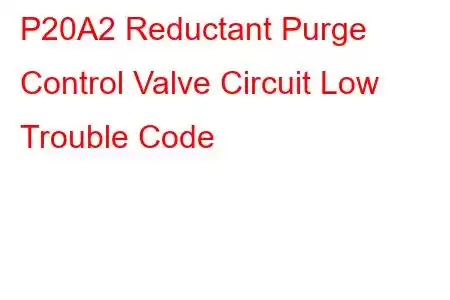P20A2 Reductant Purge Control Valve Circuit Low
OBD-II Trouble Code Technical Description
Reductant Purge Control Valve Circuit Low
What does that mean?
This is a generic powertrain diagnostic trouble code (DTC) and applies to many OBD-II diesel powered vehicles (1996-newer). That may include but is not limited to vehicles from Chevrolet, GMC, Ford, Mitsubishi, VW, Sprinter, Audi, etc. Although generic, the exact repair steps may vary depending on year, make, model and powertrain configuration.
OBD-II trouble code P20A2 and related codes P20A0, P20A1, P20A3, P20A4 and P20A5 are associated with the reductant purge control valve circuit. This circuit is also known as the diesel exhaust fluid system (DEF).
The purpose of the reductant purge control valve circuit is to send a signal to Power Control Module (PCM) or the Engine Control Module (ECM) as a reference point to determine when the reductant pump needs to reverse flow and purge the DEF system. This process is used to assist in converting leftover exhaust particles into harmless gases. The DEF system is designed to convert harmful NOx gases to Nitrogen, Carbon Dioxide, and water to protect the environment.
When the PCM or ECM detects voltage or resistance that is below normal programmed parameters within the reductant purge control valve circuit, code P20A2 will be set and the check engine light will be illuminated.
A mechanic:
What is the severity of this DTC?
The severity of this code is normally moderate, but P20A2 can be severe if harmful gases are being expelled from the exhaust which becomes a safety concern requiring immediate attention.
What are some of the symptoms of the code?
Symptoms of a P20A2 trouble code may include:
Poor engine performance Decreased fuel economy Check engine light illuminatedWhat are some of the common causes of the code?
Causes for this P20A2 code may include:
Defective reductant purge control valve Faulty or damaged wiring Loose or defective control module ground strap Corroded, damaged or loose connector Defective fuse or fuse-able link (If applicable) Defective PCM or ECMWhat are some P20A2 troubleshooting steps?
The first step in the troubleshooting process for any malfunction is to research the Technical Service Bulletins (TSB's) for the specific vehicle by year, model and power plant. In some circumstances, this can save a lot of time in the long run by pointing you in the right direction.
The second step is to locate all components associated to the reductant purge control valve circuit and look for obvious physical damage. Based on the specific vehicle, the DEF system may incorporate several components including an electrically operated reductant pump, purge valve, pressure sensor, integrated level sensor, temperature sensor, system heaters, filters, an electrically controlled reductant injector and a reservoir. Perform a thorough visual inspection to check the associated wiring for obvious defects such as scraping, rubbing, bare wires, or burn spots. Next is to check the connectors and connections for security, corrosion and damaged pins. This process must include all wiring connectors and connections to all components including the PCM or ECM. Consult the specific tech data for the vehicle to see if a fuse or fuse-able link is incorporated into the circuit.
Advanced Steps
The advanced steps become very vehicle specific and require the appropriate advanced equipment to perform accurately. These procedures require a digital multi meter and the specific technical references for the vehicle. In this situation, a pressure gauge may also be required to assist the troubleshooting process.
Voltage Checks
The reference voltage and the acceptable ranges may vary based on the specific vehicle and the circuit configuration. Specific technical data will
Read: 21


